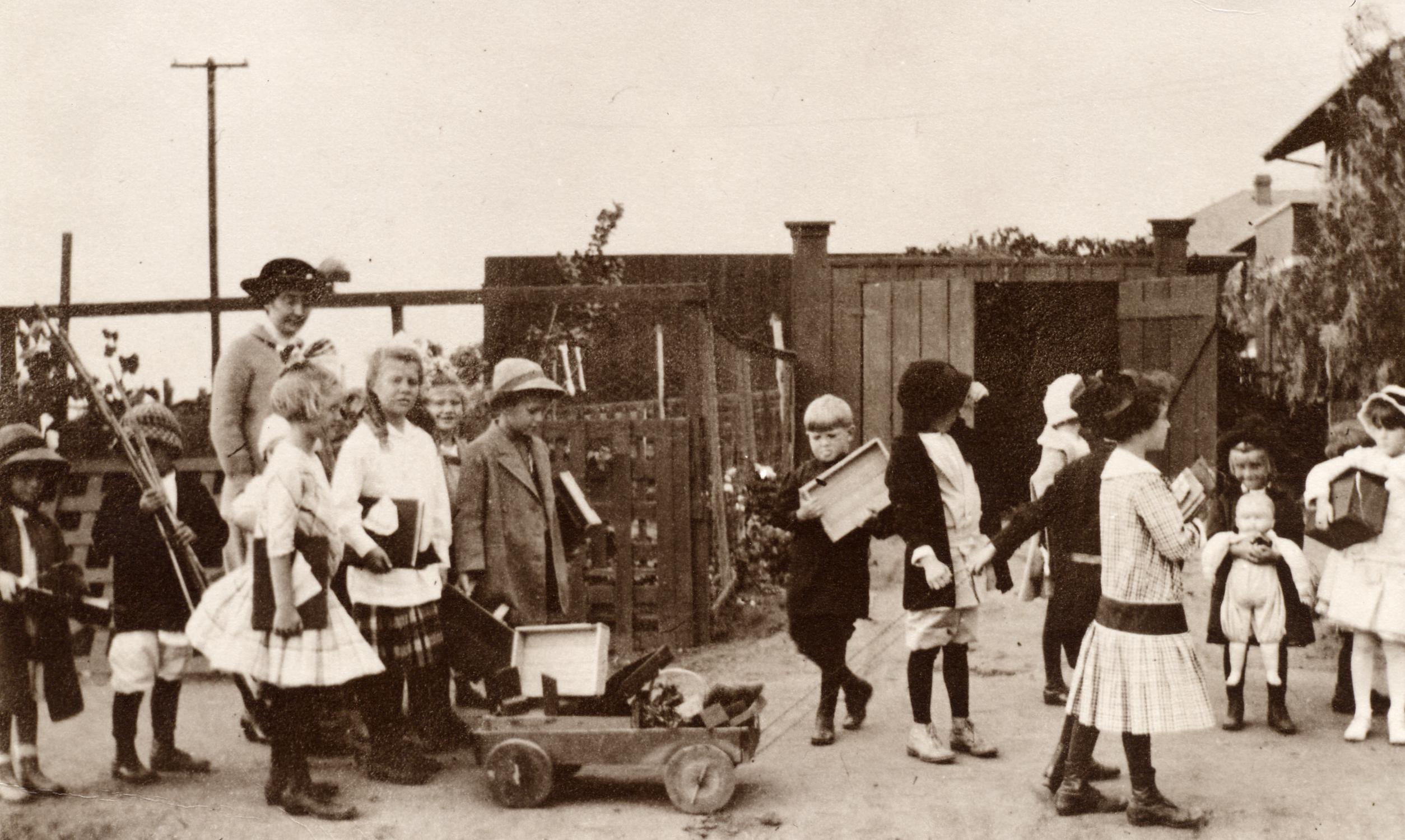
Above: Parker students and teachers at the Mission Hills Campus in 1913.
The doors of Francis Parker School first opened, in Mission Hills, on December 31, 1912. Founders Clara Sturges Johnson and her husband, William Templeton Johnson, based their educational philosophy on the work of Colonel Francis Wayland Parker and the experience of the Chicago school where Col. Parker’s principles were first put into practice.
Known as “the father of Progressive Education,” Colonel Parker was born in New Hampshire in 1837. He began teaching at the age of 16 and at 21 became principal of a school in Carrollton, Illinois. He acquired the rank of Colonel in the Civil War.
After the war, Colonel Parker became superintendent of schools in Quincy, Massachusetts, where his research and work became widely known. He moved to Chicago to become principal of Cook County Normal School and was then named to the Presidency of the Chicago Institute, which shortly thereafter became the School of Education of the University of Chicago, with Colonel Parker its Director.
Parker’s work, influenced greatly by Horace Mann, emphasized the role of the classroom teacher, calling “spontaneous enthusiasm in the work of the classroom” the teaching quality he “prized above all others.”
His ideas and educational objectives were later carried out in the establishment of the Francis Parker School in Chicago one year before he passed away.
With the inspiration of Colonel Parker and their desire to create a progressive educational system in San Diego, Clara and William Johnson opened the Francis W. Parker School in a cottage at the corner of Randolph and Fort Stockton Streets, where the San Diego Mission Hills Nursery now stands. In the first year, they had three students; by the time the first buildings were completed at 4201 Randolph Street, enrollment stood at 30 students.
William Templeton Johnson was not only the School’s co-founder, he was also the original architect. Subsequently, he was the designer of landmark buildings in San Diego such as the Serra Museum in the Presidio, the Fine Arts Gallery (now the San Diego Museum) and the San Diego Trust and Savings Bank.
In designing the School, the Johnsons believed strongly in the importance of the physical environment to the education of children. Expanding on Colonel Parker’s fundamental ideas, the Johnsons designed the architecture to reflect the educational goals and philosophy of the School program.
With the understanding that learning is enhanced by state-of-the-art buildings that incorporate inspired architecture, natural light, fresh air and environmentally sustainable technologies, the recently completed renovation of the Linda Vista campus demonstrates the School’s ongoing commitment to a tradition of progressive education.
Parker’s principal from 1913–1920, Adele Outcalt, summed up the founders’ primary objective: “To found a school which, by its environment, its methods, its opportunities, would develop the young for participation in citizenship—
the world’s work.”
During the 1950s and ‘60s, Parker’s enrollment increased from 130 to 330 students. The operating budget nearly tripled, and, for the first time since the Depression, high school grades were reintroduced to the School: 10th grade in 1962, 11th grade in 1967, and 12th grade in 1968. Buildings on the Mission Hills Campus were expanded to meet the increased student demand and program changes were implemented as required to accommodate the new high school courses. A premium was placed on education through travel, including taking students on trips through National Parks and an annual trip to guest lodges in Tecate, Mexico.
In 1971, Parker saw an opportunity to meet an increased demand for independent school education in San Diego. The Board of Trustees approved the purchase of the San Miguel School for Boys, an Episcopal boarding school in the Linda Vista community, for $1.2 million. The Linda Vista Campus would house the 7th-12th grades, leaving the lower grades at the historic Mission Hills Campus.
In December 1973, the bank that carried the School’s line of credit failed, and the bank’s successor called in some of Parker’s outstanding notes that had been used to purchase the Linda Vista property. Through a series of urgent appeals to its families, and the sale of a portion of the land in Linda Vista, the School weathered the financial crisis. The School went on to add new buildings on the Linda Vista Campus to accommodate an ever-growing enrollment, including the opening of the Middle School classroom building in 1986.
By the end of the 20th Century, enrollment at Parker rose to 1,000 students, and, for the first time in its history, the School turned away student applicants at all grade levels. Advanced Placement offerings in the Upper School increased by 30%, and the entire School turned to a more global focus in the educational program. Foreign exchange students arrived at the Upper School, and educational trips abroad expanded to include programs in Europe, Africa, and Central America. The Amelita Galli-Curcci Performing Arts Center was opened in 1998. The operating budget, reached $20 million, including more than $1.5 million in tuition assistance for families of limited financial means.
Throughout the first decade of the 21st Century, the Upper and Middle School campus in Linda Vista, along with the Lower School grounds in Mission Hills underwent a six-phase Master Plan that was privately funded to the tune of $70 million. Between 2004 and the start of the school year in 2009, Parker constructed 15 new buildings including 40 new, and 19 renovated, classrooms. Also added were new athletic fields, two libraries — Considine Library on the Mission Hills campus and the Linda Vista Campus Library, the Scripps Lecture Hall, three labs on the Mission Hills campus and eight new labs in the Viterbi Science Center, the Tchang Science Building in the Middle School, along with the addition of the Visual Arts building, the Thieman Music Center, the Rose Art Gallery, Gildred Math Building, Anklesaria Social Studies Building, Vassiliadis English Builiding, Nicholas Commons, J. Crivello Hall, and the Peters Family Building.




